The Making of Glacier National Park
January 15, 2020
What on earth do you suppose is this giant contraption? What could it have to do with Glacier National Park? To discover the answers, read on.
Early railroad travel within the northern U. S. was primarily from the east coast's major cities, such as New York, to as far west as Minneapolis. There was no easy way to reach the west coast. In 1879 the Great Northern Railroad, newly reorganized, decided to extend the line from Minneapolis to Seattle, 1665 miles according to a modern road atlas. It was not as if there was absolutely no track in place, some segments of rail lines existed, and by 1885 they had reached Devils Lake, ND and the border of Montana, by 1887. The problem ahead was crossing the Continental Divide. In 1891 the task was accomplished and owed to the brilliant reconnaissance work of Engineer, John Stevens, who discovered the Marias Pass crossing point and who is memorialized by his statue at the summit. Early in 1893 the final spike was driven, and by midsummer of that year, Seattle was linked to the East Coast.
Of course, Great Northern was not out just to lay track. Naturally, they had to pay for this adventure and wanted to earn great quantities of money, but that required population along the route to grow, make, and buy things requiring transport as well as to ride on the trains. Accordingly, the company undertook advertising in Scandinavia and Germany in order to persuade those people of the superb farming and ranching lands available at bargain prices – homestead pieces gratis, in fact – in the West. At low cost to them it brought families over to the U.S. and outfitted train cars especially to transport them. Great Northern received no land grants but purchased its property from the government and resold plots to the new arrivals.
Furthermore, the builders had been awed by the scenery in northwest Montana, in what we recognize today as Glacier National Park. Bringing people to the area would not fail to popularize it and produce additional revenue for the Railroad, which was the only way to reach it. A principal obstacle to tourism, however, was that by treaty the Blackfeet Indians owned most of the territory.
In 1895, though, the tribe was persuaded to sell the government 800,000 acres for 1.5 million dollars, which, per acre, should qualify as a gift. In 1897 the parcel was designated a forest preserve, with the understanding that, as long as it remained public land, the Blackfeet would retain access for hunting, and other rights they enjoyed at the time.
Forest preserves, however, lack housing and other tourist facilities, and an effort, spearheaded by the Railroad President, Louis Hill, among others, was mounted to declare the area a national park. In 1910 U.S. President Taft signed that law, which opened the way for development and underhandedly expelled the Blackfeet. For many years there were armed confrontations between the government and the tribe members.
It is impossible to neglect the bison in any account touching the transit of railroads through the West and involving Native Americans. All of us know that the extermination of that animal was a tool in removing the Indian from the scene and facilitating the construction of railroads and settlements. It was stated by a bison hunter that the U.S. government awarded his kind free ammunition, more even than they could use. We also have been educated to the fact that hordes of bison were slaughtered to feed railroad construction workers.
An example of one of the famous buffalo hunters is Buffalo Bill Cody. After fighting in the Civil War, William Cody worked for the Kansas Pacific Railroad to supply buffalo meat to their workers and succeeded so well that in 1867 he killed 4,282 of them. In 1868 there was a contest between Bill Comstock, another famous hunter, and him to see who could slaughter more in a 24-hour period. Using what he called the billiards method of hunting, Cody won. He rode his horse to the front of the herd and began shooting. When the animals formed a circle in defense, he just pinged them off one after another. Comstock hunted rather like a coyote, chased from behind and killed.
The buffalo blind, exemplified in Jane's painting, shows a different approach, a man-made rock wall guarding a then-wood covered cave, high on a hillside outside Miles City. Sharpshooters used 45/120 Sharps rifles to decimate the buffalo population. They were paid twenty-five cents an ear.
Historical reports indicate that in Montana the great carnage had passed just a few years before the Great Northern project reached the state. It is recorded that the bison extermination here occurred between 1883 and 1884.
In 1881 200,000 hides were shipped east from the area bounded by the Missouri, Yellowstone, and Musselshell Rivers, and there were 5000 hunters and skinners on the northern range. In 1883 40,000 skins had been shipped from Miles City – Glendive, but there were fewer than 100 in 1884. A White Sulphur Springs resident commented on seeing a great number of them along the Musselshell in 1881 and 1882, but only a few in 1884; that "The Montana buffalo seems to have disappeared in a year or two."
One may well ask, nevertheless, if the Great Northern didn't conspire with bison hunters and others to slaughter the animals in advance of its coming and thereby facilitate it's crossing the High Plains, but there is no documentation of such a plot.
With hides the objective of the killing, uncounted tons of meat were abandoned on the prairie to rot or to be put to favorable use by Nature's scavengers. In a short time, then, the land became an enormous repository of bison skeletons until it occurred to other opportunists that bone has many industrial uses; for example, in bone china. At that time the plains were invaded by another species of scavenger, bone hunters, who shipped tens of thousands of tons of it again back east, the desires and fashions of which people dictated the fate of the West.
Eventually, cleared of the refuse of the slaughter, the plains became beautiful, but with cattle, and less so by the irretrievable loss of the magnificent creatures that had dominated them.
At any rate, there was a national park, yes, with a railroad along its southern border, but it lacked roads into the region, so Railroad President, Hill, caused to be built a series of elegant chalets and huge, magnificent lodges, along with camping sites. The structures were one-day horse rides or horse-drawn wagon rides apart, and the Great Northern created a one-week itinerary that utilized them. For those in the East it was advertised as a restful, healthful vacation. In terms of immediate revenue, this was a non-profit scheme, but it served to endear the region to thousands of visitors, which meant future income.
The subject of Park buildings brings us again to our leading painting. On the reverse of the old photograph on which it was based is written, "Taking boiler across McDonald Lake. G.N.P.," which abbreviation we recognize not as Gross National Product, but as Glacier National Park.
Thus, the item absorbing the men's attention is a boiler, likely part of the heating plant of one of the new buildings, possibly the famous Lake McDonald Lodge, located at one end of the lake. The hotel is noted for the pictographs etched into the original fireplace hearth. Tradition holds these to be the work of artist, Charles Russell
Why the sled, though, over the frozen lake? Again, because there were no roads. White Fish, in fact, was known as Stump Town, for one had to drive a vehicle over tree stumps left behind in lieu of a normal road. (The lack of normal roads is no surprise to those of us in Musselshell County.)
In the early days there were but two pieces of private property in the vast expanse that was Glacier National Park, and next week we shall tell you about the fascinating woman that occupied one of them.

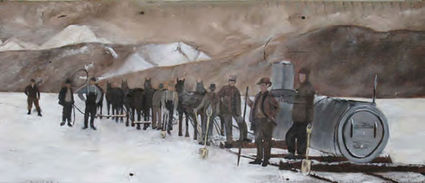
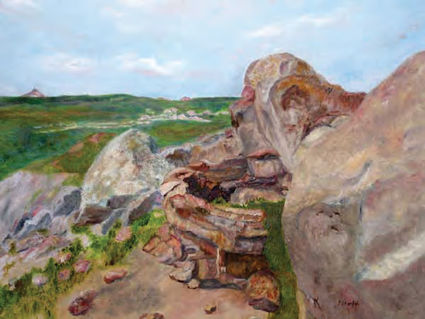
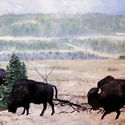
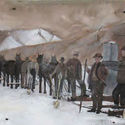
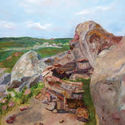



Reader Comments(0)